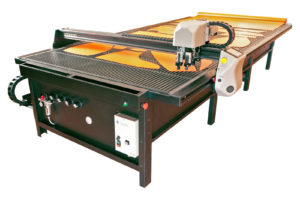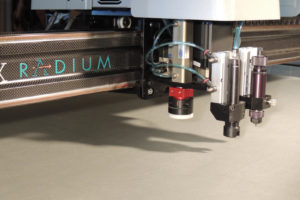
Taking the time now to learn about automated manufacturing processes can save time in the long run, while increasing productivity and revenue.
Automated cutting and the associated use of CAD software has been available to those processing textiles since the late 1980s. While technology has matured, price has come down and industry acceptance has grown, many companies continue to hand cut their materials.
Companies that have invested in automated cutting equipment and software report fast returns on their investment as they experience advantages such as time savings, improved part accuracy and material savings. There are other advantages that may be overlooked, however: Converting to ‘just in time’ manufacturing allows companies to reduce on-the-shelf inventory levels. Digital pattern design and storage improve a business’s organization, as patterns no longer get damaged or lost. Automated cutting machines are safer than hand cutting, especially when compared to powered stack-cutting tools.
Most will agree that automated manufacturing processes enhance production quality, consistency and output. Still, it can be difficult to imagine your own businesses taking this step. What myths might be standing in the way of the decision to automate your pattern cutting?
Myth 1: We can’t afford to automate
The purchase price of a new machine may cause you to think you can’t afford to automate. If any of us went to a car lot and looked at a new car, and only considered the sticker price, we would all determine that we can’t afford to drive. It is only after we take into account how long it will take us to walk to all our destinations that we appreciate the value and freedom the car affords.
The same holds true when considering automated cutting systems. You must carefully weigh the value the equipment brings to your production processes and compare that to the equipment cost. People get stuck on the sticker price, fear takes over, and inaction can occur. Once inaction occurs, the business is in danger of remaining stagnant, and a stagnant business will eventually cease to be viable in its industry and market segment.
The truth is that automated cutting equipment can cost less than a single new employee and yet perform the production throughput of several employees. Consider all that automated cutting will improve in your factory: cost of goods savings, increased production, error elimination, enhanced part quality, employee job satisfaction, growth and increased revenue.
Myth 2: Automation puts people out of work
Automated equipment does the job laborers used to do, so it seems these people are now out of a job. In our experience, customers using automated cutting equipment have employees who are no longer doing the manual jobs the cutting machine is now performing. They are the machine operators or have moved to a new position within the company—often a more creative, skilled or challenging position.
In 1998 Autometrix Inc. sold a cutting machine to a furniture cushion manufacturer to help speed up production and eliminate errors. Within a few years, the benefits realized from their first automated machine led to the addition of several more automated machines, two new buildings and hundreds of new employees. Automating enabled the company to grow exponentially, opening the doors of employment to many people in their rural area.
Myth 3: We’ll need to hire someone to operate the machinery and software
People can be intimidated by complex software or machine operations. Automation manufacturers want to solve your production pinch points, not add to them. Overly complicated systems create a difficult selling position for equipment manufacturers. If the equipment is too difficult to use, companies will always be leery of buying it.
Several years ago Autometrix leased a big all-in-one printer that did it all: print color and black and white, print two-sided, print on card stock, print a book, collate, maybe even bind. The expectation was to print all marketing materials and never have to go out of house to print anything. The problem occurred when no one could remember how to perform the simplest task, or when the paper jammed and opening the side door revealed an array of belts, levers, trays and red flashing lights. No one felt comfortable using it, and in the end the salesman was called and politely asked to come pick it up. A new desktop printer/scanner now performs the necessary functions with ease.
Automation should be about making things work better, faster and smarter. It is the machine manufacturer’s job to make sure this is accomplished with ease, and to provide solutions that mesh well with your company and your employees.

Myth 4: Automation is only good for mass production, not custom work
If you are manufacturing the same part over and over again, it’s easy to see how automating that process makes sense. However, if you offer custom parts or sizes, how can the cutting machine adjust to the ever-changing demands? Automated cutting machines are controlled by a computer program, and operators can plug in whatever pattern file they want. Some companies include design software, and some simply import the files from a third-party design software. This is not a “programming” process, but a straightforward task of sending a CAD file to the machine with a click of a button.
If different sizes of a product are common in your business, the use of parametric design software will allow the user to change the shape and size of a given pattern style. By editing existing dimensions, a new pattern can be instantly created based on a set of design rules. Software is essential to gain the most advantages from any investment in a system. Spend enough time examining and testing the software necessary to design your parts and run the equipment. Once you are familiar with the software, custom work will become less challenging and more profitable than doing it by hand.
Myth 5: Our Company is too small to automate
Define what “too small” really is by honestly answering these questions: Do I have a business or a hobby? If I have a business, do I want to grow the company and profits, or stay small?
About five years ago, Autometrix sold a cutting machine to a small, family-owned upholstery shop. It quickly grew from a small shop that did a few jobs a week to one that had enough confidence to bid on and win a complete remodel for a large restaurant chain.
Most manufacturers of automated cutting equipment have several models at various price points. Many offer an introductory model, without all the bells and whistles, and this is often the best introduction to automation.
Myth 6: It is better, and less costly, to start with used equipment
Many businesses looking to get into automation find used equipment at a very attractive price, only to discover the equipment is obsolete and parts are no longer available.
Software is usually non-transferable, so after the machine is purchased a software license will need to be purchased separately. Once the used machine is up and running, and the software purchased and installed, how long will it perform before needing a major repair or even replacement? Now that you understand how important this equipment will be to your operation, do you really want to buy an old used machine, only to constantly worry about a breakdown or having to replace it at any moment?
Consider the advantages of new equipment over used: the new systems come with the latest technology and software; the lifespan of the equipment is at maximum; the machine will be exactly what your company needs; support and parts are readily available; and it comes with training and a factory warranty.
Do your homework, ask the tough questions, test the software and talk to others in your industry who have already automated to decide if it’s the right direction for your company.
Terri Van Wagner is the account manager for Autometrix Inc., working from the corporate office in Grass Valley, Calif.
 TEXTILES.ORG
TEXTILES.ORG


